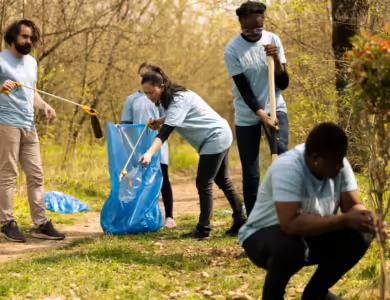7 Ultimate Guide to Landing Perfect Sponsors for Your Events

Do you need help to secure the right sponsors for your events? Planning an event is challenging enough, but finding sponsors who align with your vision can feel like an uphill battle. Your event might stay within its potential with proper support, leaving attendees well-rested and your goals met. Fortunately, there’s a solution. Our Ultimate Guide to Landing Perfect Sponsors for Your Events will equip you with proven strategies to attract and secure ideal partners. From innovative event sponsorship ideas to effective sponsor engagement techniques, we’ll show you how to transform your sponsorship game and elevate your events to new heights.
Guide to Landing Perfect Sponsors That Drive Success
Mastering the art of landing perfect sponsors is crucial for driving event success. Whether you’re organizing a nonprofit fundraiser or a corporate conference, the right sponsorship can make all the difference. This guide will walk you through cutting-edge event sponsorship strategies that go beyond traditional approaches. You’ll discover creative ways to attract sponsors, learn how to craft irresistible proposals and explore techniques for building lasting partnerships. By implementing these sponsor engagement tips, you’ll not only secure valuable support but also enhance the overall experience for your attendees. Get ready to revolutionize your approach to event sponsorship and unlock the full potential of your next gathering.
1. Crafting Compelling Sponsorship Proposals
Crafting compelling sponsorship proposals is the cornerstone of securing event sponsors. A well-crafted proposal can be the difference between a potential partner scrolling past or eagerly reaching out to collaborate. When creating your proposal, focus on presenting a clear, concise, and engaging document that highlights the unique value your event offers.
Start by researching each potential sponsor thoroughly. Understanding their brand, values, and target audience allows you to tailor your proposal specifically to their needs. This personalized approach demonstrates your commitment and increases the likelihood of a positive response. In your guide to landing perfect sponsors, emphasize the importance of aligning your event’s goals with those of the sponsor.
Your proposal should paint a vivid picture of the benefits sponsors can expect. Outline concrete opportunities for brand visibility, such as prominent logo placement or speaking slots. Discuss audience engagement strategies that will put the sponsor in direct contact with their target market. Most importantly, provides a clear breakdown of the potential return on investment (ROI). Use data from past events or industry benchmarks to support your claims. Remember, corporate sponsorship strategies often revolve around measurable outcomes, so be prepared to offer specific metrics for success.
For nonprofit sponsorship proposals, focus on the emotional and social impact of the partnership. Highlight how the sponsor’s involvement will contribute to the cause and enhance their corporate social responsibility profile. This approach can be particularly effective when targeting companies with strong community values.
Lastly, pay attention to the presentation of your proposal. A professionally designed document with compelling visuals can significantly boost your chances of success. Consider including infographics, charts, or previous event photos to break up text and illustrate key points. By following these sponsorship proposal tips, you’ll be well on your way to securing event sponsors that truly elevate your gathering.
2. Leveraging Social Media for Sponsor Outreach
Now that you’ve crafted a compelling sponsorship proposal, it’s time to amplify your outreach efforts through social media. In today’s digital age, leveraging social platforms for sponsor engagement has become an essential strategy in securing event sponsors.
Social media sponsor outreach allows you to cast a wider net and connect with potential partners in a more dynamic, interactive way. Start by identifying the platforms where your target sponsors are most active. LinkedIn might be ideal for B2B events, while Instagram or TikTok could be more suitable for consumer-focused gatherings. Once you’ve pinpointed the right channels, develop a content strategy that showcases your event’s unique value proposition.
In your guide to landing perfect sponsors, emphasize the power of consistent, engaging content. Share behind-the-scenes glimpses of your event planning process, highlight success stories from previous sponsors, and create teasers that generate buzz around your upcoming event. Don’t forget to tag potential sponsors in relevant posts, especially when sharing content that aligns with their brand values or target audience. This approach not only increases visibility but also demonstrates how a partnership could benefit their online presence.
For nonprofit organizations, social media outreach can be particularly effective. Use storytelling techniques to illustrate the impact of your cause and how sponsor involvement can make a difference. Share user-generated content from past events to showcase the engagement and reach sponsors can expect.
Remember, digital sponsorship strategies go beyond mere promotion. Engage with your potential sponsors’ content by liking, commenting, and sharing their posts. This two-way interaction builds relationships and keeps your event on their radar. By implementing these event sponsorship ideas and maintaining an active, professional social media presence, you’ll create a strong foundation for attracting and securing sponsors who are eager to be part of your event’s success story.
3. Hosting Sponsor Networking Events
While social media outreach is crucial, nothing beats the power of face-to-face interactions when it comes to landing event sponsors. Hosting sponsor networking events is a highly effective strategy that can significantly boost your sponsorship efforts.
These exclusive gatherings create an environment where potential sponsors can mingle with industry leaders, key stakeholders, and even past sponsors in a relaxed, informal setting. This approach allows you to showcase your event’s value proposition in person, addressing any questions or concerns directly. It also provides an opportunity for sponsors to see firsthand the caliber of connections they could make through your event.
In your guide to landing perfect sponsors, emphasize the importance of carefully curating these networking events. Choose a venue that reflects the prestige of your event and the caliber of sponsors you’re targeting. Plan activities that encourage interaction and conversation, such as icebreakers or brief presentations from previous sponsors sharing their success stories. Remember, the goal is to create an atmosphere where potential sponsors can envision the benefits of partnering with your event.
For nonprofit organizations, these networking events can be particularly impactful. They offer a chance to demonstrate the passion behind your cause and the tangible difference sponsors can make. Consider inviting beneficiaries of your work to share their stories, providing a powerful emotional connection for potential corporate sponsors.
When executing sponsor engagement strategies like these networking events, timing is key. Host them well in advance of your main event to allow ample time for follow-ups and negotiations. Use these gatherings as an opportunity to distribute your carefully crafted sponsorship proposals, now backed by the personal connections you’ve fostered. By combining the digital outreach discussed earlier with these in-person networking opportunities, you’re creating a comprehensive approach to securing event sponsors that’s hard to resist.
4. Offering Tailored Sponsorship Packages
Having established connections through networking events, it’s time to focus on creating sponsorship packages that truly resonate with potential partners. Offering tailored sponsorship packages is a game-changing strategy that can significantly increase your success rate in securing event sponsors.
One-size-fits-all approaches often fall short in today’s competitive sponsorship landscape. Instead, crafting customized sponsor offers that align with each potential partner’s specific goals and brand identity can make your event irresistible. Start by thoroughly researching each prospective sponsor’s marketing objectives, target audience, and past sponsorship activities. This information will guide you in creating packages that speak directly to their needs and aspirations.
Your guide to landing perfect sponsors should emphasize the importance of flexibility in sponsor package creation. Develop a range of options that cater to different levels of involvement and investment. For instance, you might offer tiered packages such as “Gold,” “Silver,” and “Bronze,” each with increasing levels of visibility and benefits. However, don’t stop there. Be prepared to adjust these packages based on individual sponsor feedback and requirements.
For nonprofit organizations, consider creating sponsorship packages that highlight the social impact of the partnership. Showcase how different levels of sponsorship can contribute to specific goals or programs within your organization. This approach can be particularly effective in attracting corporate sponsors looking to enhance their corporate social responsibility profile.
When designing corporate sponsorship strategies, focus on providing clear, measurable returns on investment. This could include guaranteed media exposure, lead generation opportunities, or exclusive access to your event’s attendees. Remember, the key is to demonstrate how each element of your sponsorship package contributes to the sponsor’s business objectives. By offering tailored, value-driven packages, you’re not just securing event sponsors – you’re creating long-term partnerships that benefit both parties.

5. Utilizing Event Data to Attract Sponsors
While tailored sponsorship packages are crucial, backing them up with solid data can significantly boost your chances of securing event sponsors. Utilizing event data to attract sponsors is a powerful strategy that can set your proposals apart in a competitive landscape.
In today’s data-driven world, potential sponsors are looking for more than just promises – they want concrete evidence of the value your event can provide. By leveraging event data from previous gatherings, you can paint a clear picture of the potential return on investment. This approach transforms your pitch from a speculative opportunity into a calculated business decision for sponsors.
Your guide to landing perfect sponsors should emphasize the importance of collecting and analyzing comprehensive event data. This includes attendee demographics, engagement metrics, social media reach, and post-event survey results. For nonprofit organizations, event analytics can also include data on funds raised, volunteer engagement, and the social impact achieved. These insights allow you to craft data-driven sponsorship strategies that speak directly to each sponsor’s goals and target audience.
When presenting event data to sponsors, focus on metrics that align with their specific objectives. For instance, if a sponsor is looking to increase brand awareness, highlight data on media impressions and social media engagement from previous events. If they’re more interested in lead generation, provide statistics on the number of qualified leads generated or business connections made during past gatherings.
Remember, sponsor engagement through data isn’t just about presenting numbers – it’s about telling a compelling story. Use visuals like infographics or interactive dashboards to make your data easy to understand and impactful. By effectively leveraging event data, you’re not just securing event sponsors; you’re building trust and credibility that can lead to long-term partnerships. This data-centric approach demonstrates your professionalism and commitment to delivering measurable results, making your event an attractive investment for potential sponsors.
6. Engaging Sponsors Through Creative Branding Opportunities
Building on the foundation of data-driven strategies, it’s time to explore how creative branding opportunities can elevate your sponsorship offerings. Engaging sponsors through innovative and memorable branding experiences can be a game-changer in securing event sponsors and ensuring their long-term commitment.
Gone are the days when simply plastering a sponsor’s logo on event materials was enough. Today’s sponsors are looking for immersive, interactive ways to connect with your audience. This shift calls for event organizers to think outside the box and develop sponsor branding strategies that seamlessly integrate into the overall event experience.
Your guide to landing perfect sponsors should highlight the importance of tailoring these creative branding opportunities to each sponsor’s unique identity and goals. For instance, a tech company might appreciate a branded virtual reality experience, while a food and beverage sponsor might prefer an interactive tasting booth. The key is to create moments that not only showcase the sponsor’s brand but also add value to the attendee experience.
For nonprofit organizations, creative sponsor branding can take on an even more meaningful role. Consider how you can align a sponsor’s brand with your mission in ways that resonate emotionally with attendees. This could involve interactive exhibits that showcase the sponsor’s contribution to your cause or collaborative art installations that bring your shared values to life.
When developing corporate branding for events, consider the entire attendee journey. From registration to post-event follow-ups, each touchpoint offers an opportunity for innovative sponsor branding. Digital content, such as sponsored live streams or exclusive app features, can extend the sponsor’s reach beyond the physical event space. By offering these unique, engaging branding opportunities, you’re not just securing event sponsors – you’re creating brand advocates who see your event as an invaluable platform for connecting with their target audience.
7. Building Long-Term Relationships with Sponsors
While creative branding opportunities can make a significant impact, the true key to long-term success lies in nurturing enduring sponsor relationships. Building and maintaining strong connections with your sponsors is not just about securing support for a single event; it’s about creating a partnership that grows and evolves over time.
Fostering sponsor loyalty requires a dedicated, year-round approach. Regular communication is crucial, keeping sponsors informed about your organization’s activities and upcoming events. This ongoing dialogue helps sponsors feel valued and involved, even outside of event periods. Consider setting up quarterly check-ins or sending monthly newsletters to keep the lines of communication open.
Your guide to landing perfect sponsors should emphasize the importance of post-event engagement. Provide comprehensive reports that showcase the value delivered, including data on attendee engagement, brand exposure, and any leads generated. These reports serve as tangible proof of the partnership’s success and lay the groundwork for future collaborations.
For nonprofit organizations, building long-term sponsor partnerships can be particularly impactful. Invite sponsors to participate in your mission beyond event sponsorship, perhaps through volunteer opportunities or collaborative projects. This deeper involvement can transform a transactional relationship into a meaningful, mission-driven partnership.
Corporate sponsor engagement strategies should focus on creating exclusive opportunities for longtime partners. This could include first right of refusal for prime sponsorship slots, early access to new event concepts, or opportunities to co-create event elements. By offering these privileges, you’re not just securing event sponsors; you’re cultivating brand ambassadors who are invested in your success.
Remember, sponsor retention strategies are just as important as acquisition efforts. Recognize and celebrate your sponsors’ contributions publicly, and always be on the lookout for new ways to add value to the partnership. By prioritizing these long-term relationships, you’ll create a stable foundation of support that allows your events to grow and thrive year after year.
FAQs:
1. What is the best way to approach potential sponsors?
Approaching potential sponsors effectively requires a tailored strategy. Start by thoroughly researching the sponsor’s brand, values, and goals. Personalize your pitch to demonstrate how your event aligns with their objectives. Clearly articulate the benefits of sponsorship, focusing on tangible ROI metrics that matter to their business. Utilize a multi-channel approach, combining well-crafted emails, strategic social media engagement, and when possible, in-person meetings. This comprehensive outreach strategy shows professionalism and dedication, increasing your chances of securing their support.
2. How do I determine the right sponsorship package for my event?
Crafting the ideal sponsorship package involves a careful balance of various factors. Consider your event’s target audience demographics and interests, as they should align with the sponsor’s target market. Assess the level of sponsor involvement you can reasonably accommodate without compromising the event’s integrity. Analyze both your event’s goals and the potential sponsor’s objectives to ensure mutual benefit. Offering a diverse range of packages, from entry-level to premium options, allows sponsors to choose a level of involvement that suits their budget and goals, maximizing your chances of securing diverse sponsors.
3. How can I measure the success of a sponsorship?
Measuring sponsorship success requires a multi-faceted approach. Track quantitative metrics such as brand visibility (e.g., logo impressions, mention frequency), audience engagement (e.g., booth visits, app interactions), and lead generation (number and quality of leads). Qualitative data is equally important; conduct post-event surveys to gauge attendee perceptions of sponsors and gather direct feedback from sponsors about their experience. Analyze social media mentions and sentiments related to the sponsorship. Compare these results against pre-established goals to provide a comprehensive view of the sponsorship’s effectiveness.
4. What are some common mistakes to avoid when seeking sponsors?
When seeking sponsors, avoid these common pitfalls: First, don’t use generic, one-size-fits-all proposals. Tailoring each pitch shows you value the sponsor’s unique needs. Second, ensure you clearly articulate the value proposition; vague benefits won’t convince sponsors to invest. Third, don’t neglect post-event follow-up; this is crucial for building long-term relationships. Fourth, avoid focusing solely on monetary contributions; consider in-kind sponsorships or other creative partnerships. Lastly, don’t promise what you can’t deliver; realistic expectations and clear communication are key to sponsor satisfaction and retention.
Further reading: Event Planning 101: 13 Ultimate Steps to Plan an Event That is Unforgettable
Conclusion
Mastering the art of landing perfect sponsors for your events is a multifaceted endeavor that combines strategic thinking, creativity, and relationship building. Throughout this guide, we’ve explored key strategies that can elevate your sponsorship game. From crafting compelling proposals and leveraging social media to hosting networking events and offering tailored packages, each approach plays a crucial role in attracting and retaining valuable sponsors.
Remember, the key to success lies not just in securing sponsors for a single event, but in fostering long-term partnerships that grow stronger with each collaboration. By utilizing event data effectively, providing creative branding opportunities, and consistently delivering value, you can transform sponsors into true partners invested in your event’s success.
As you apply these strategies to your next event, keep in mind that flexibility and adaptability are crucial. The sponsorship landscape is ever-evolving, and staying attuned to your sponsors’ changing needs and industry trends will help you stay ahead of the curve.
With this comprehensive approach, you’re well-equipped to not only secure sponsors but to create mutually beneficial relationships that will help your events thrive for years to come. So, take these insights, tailor them to your unique event needs, and watch as your sponsorship opportunities blossom into lasting, impactful partnerships.
For additional resources on perfecting your sponsorship strategy, check out Sponsorship.com for the latest industry insights and Canva for creating stunning sponsorship materials.



